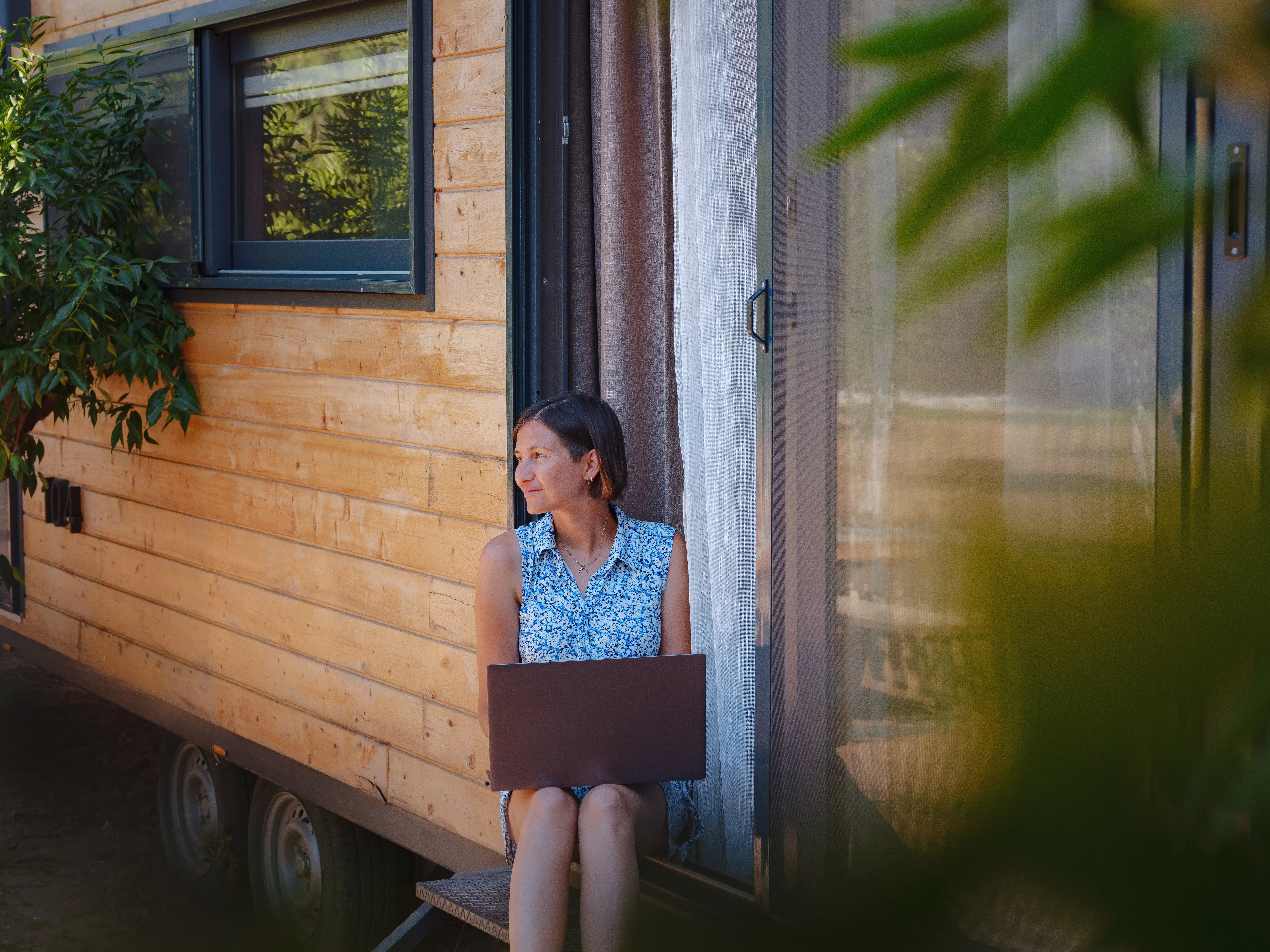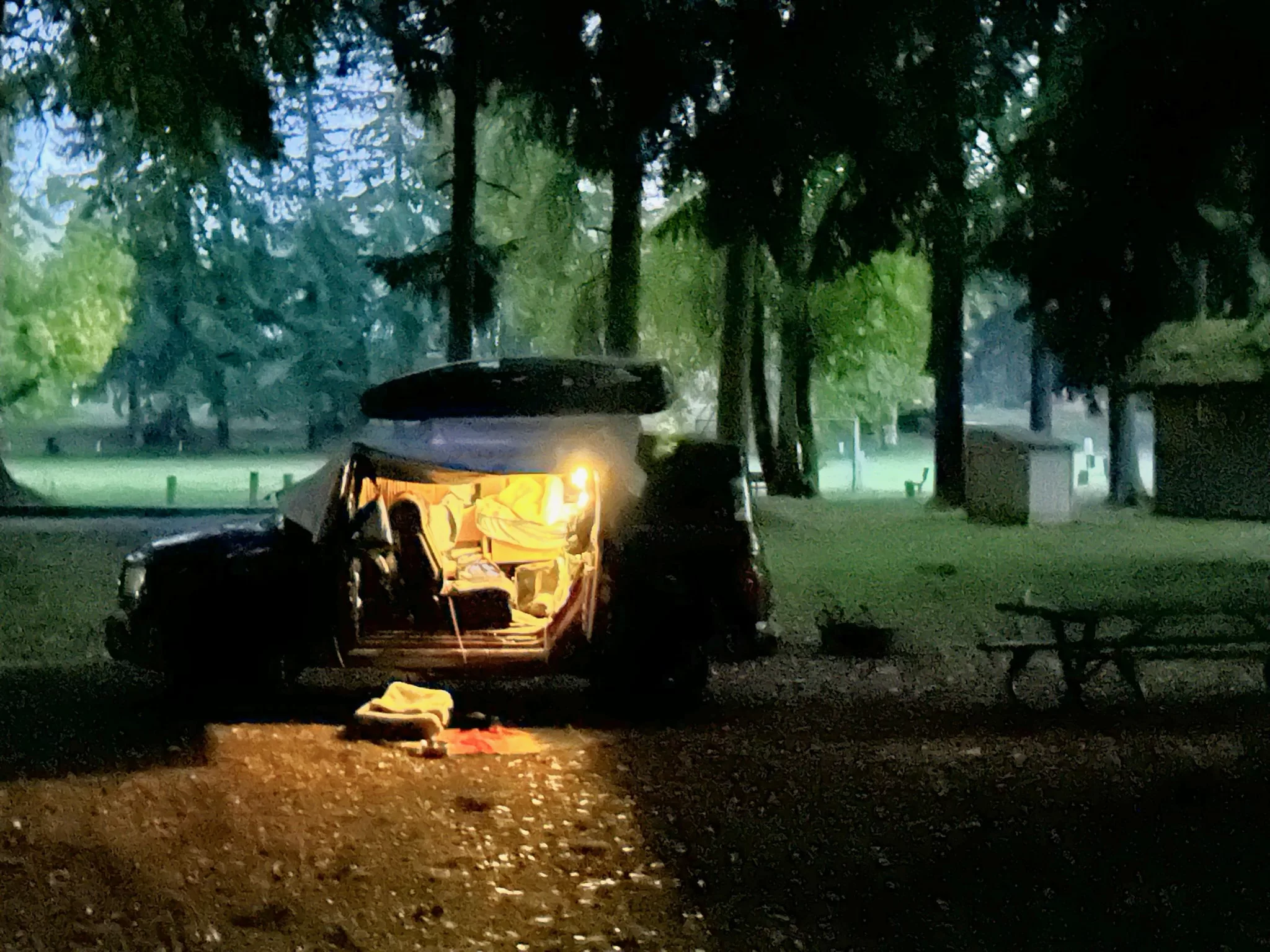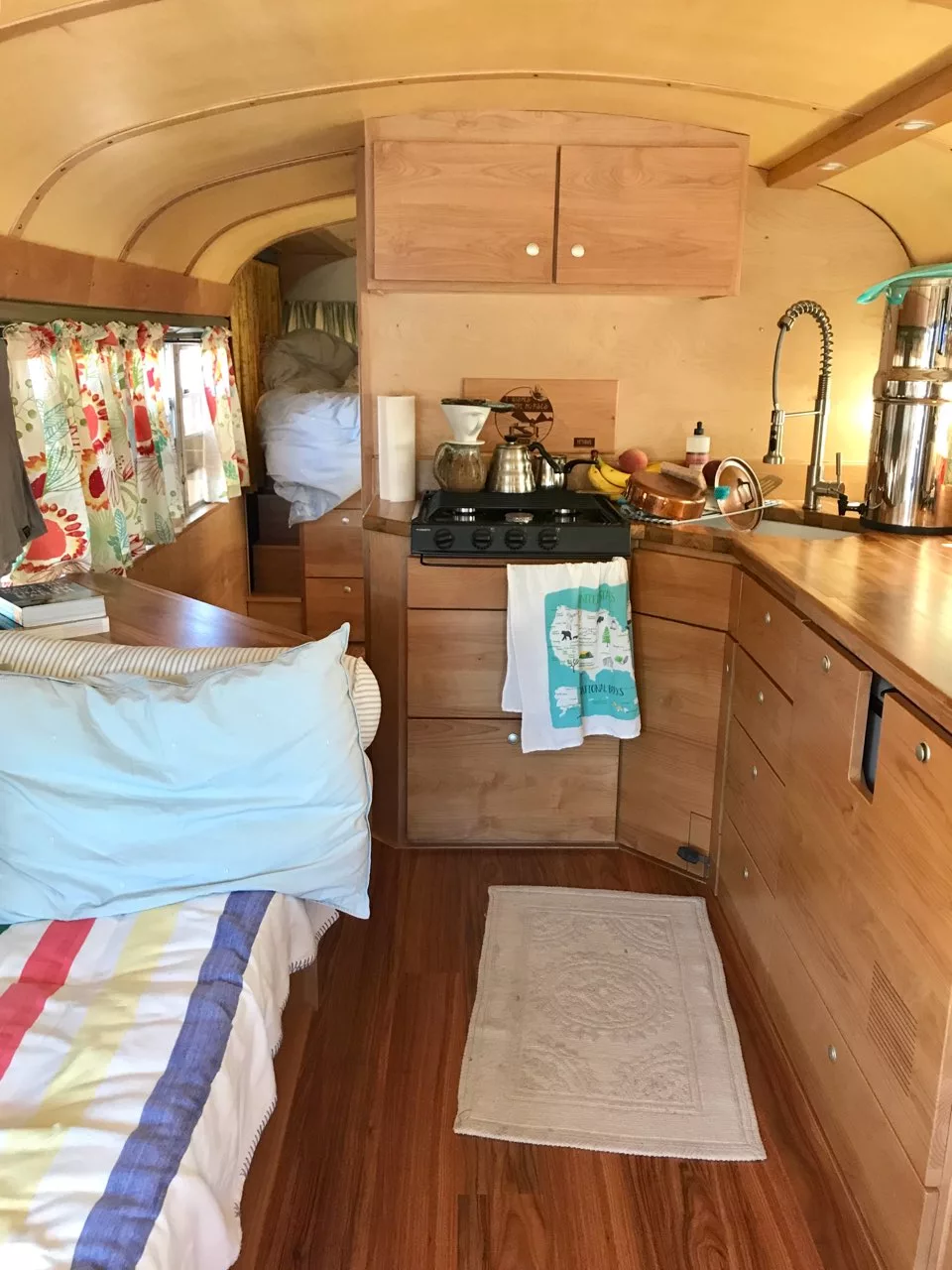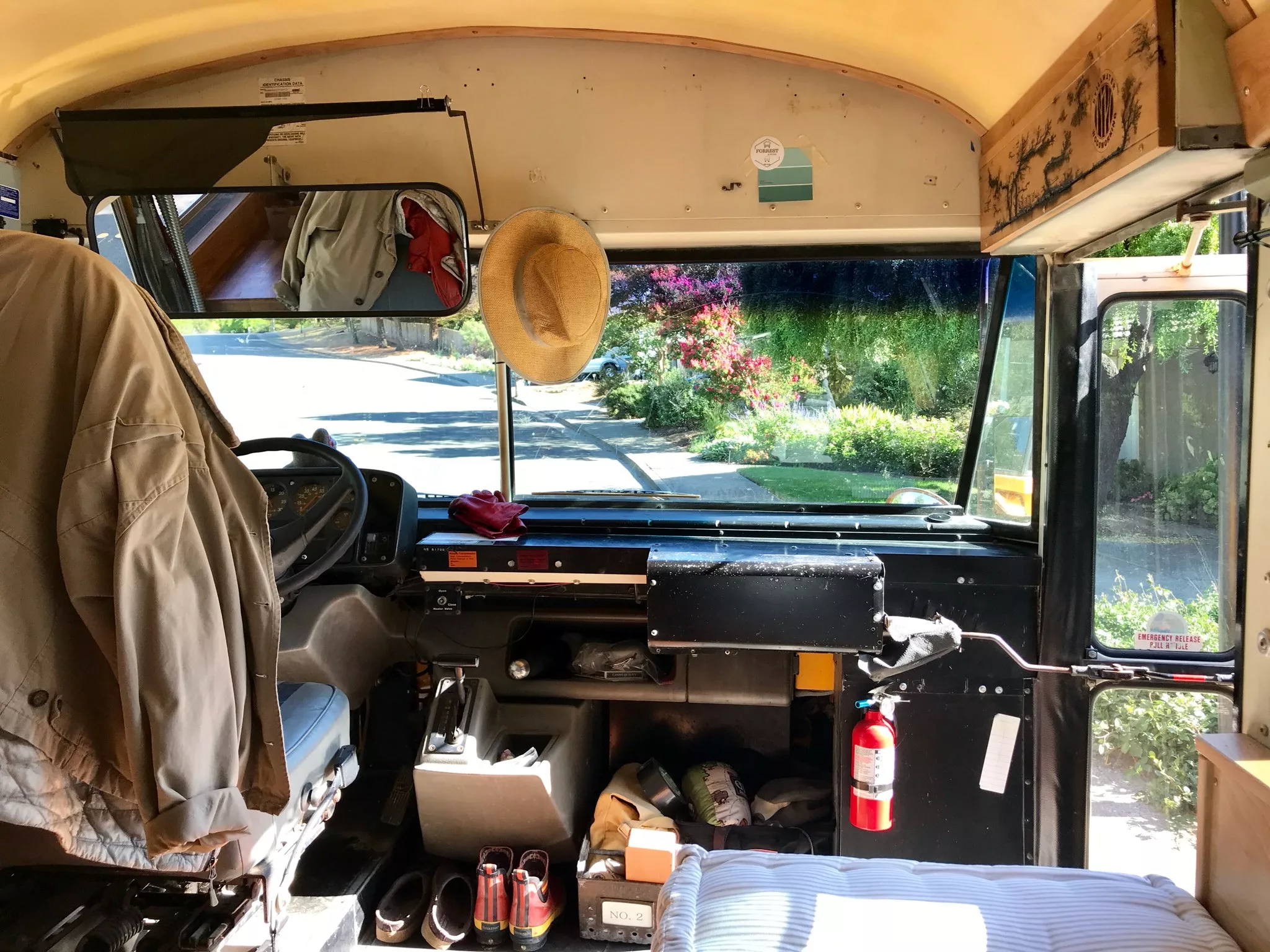
A woman—who is not one of the unnamed sources for this story—works from the step of her home-on-wheels.
As city and state officials scratch their heads while trying to find solutions to California’s homelessness problem, viable answers are slow to surface. In the midst of the debates around the situation is the fallible understanding of the makeup of the homeless population itself.
Many assume it must be addiction or mental-health problems that land people in the unfortunate situation. Those assumptions often miss the mark as mentally healthy, employed people are finding themselves unable or unwilling to continue to pay exorbitant housing costs. Among their ranks are also those who have held a long career, retired and find they can no longer afford housing costs in the area.
Some leave the state in search of cheaper housing, while others are simply moving into their vehicle so they can stay near their family, friends or work.
One reason for the continued misconception about those who are no longer in a home is that many “car dwellers” are not counted among the homeless. A growing number of those who have chosen to leave their “sticks and bricks” home do not want to risk sharing that choice with others—out of fear of losing their job or being ostracized by their community.
Among that demographic is a large and growing number of solo women who are living in their vehicles. In recent months, NBb spoke with three North Bay women about this “houseless” lifestyle. The women agreed to share their stories with an understanding they would not be identified—their names have been changed for the purposes of the article.
Kim from Marin County
It was the late 1960s and Kim was in the eighth grade when her family moved to Marin County. She enjoyed living in the area and going to school there. She remembers that the hillside across from her high school was filled with lupine and other wildflowers and the football team would run through them up and down the hill during practices.
“When I got my driver’s license, I would get up early on the weekends, drive to Point Reyes and pick up fresh-made donuts on the way home,” Kim says. “I guess I got the driving and travelers bug early, always with one foot out the door.”
She attended the College of Marin before going away to San Jose State University. She had a long career at UCSF where she did administrative work. She describes how sweet it was to ride her bicycle through Golden Gate Park in the morning on her way to work.

She became involved in the local bike coalition, a women’s art gallery and a local film association where she volunteered ushering at film festivals. She kept her home and raised her children and saw to her career. Then it was time for her to do something for herself.
She retired in 2019 from UCSF, bought a school bus and built it out for living in and traveling.
“I always knew that was something I wanted to do,” Kim says. “I went to a retirement meeting. It was kind of like a therapy session with a group of other people. And they said, draw your retirement dream. Mine was running from UCSF into my school bus, and that was like three years before I actually retired.”
Her rent was $1,500, not including utilities. She knew that her pension and social security would not cover that and allow her to have any other kind of life. “I would have to go back to work someplace else and I really didn’t want to do that,” she says. “I had worked for 45 years, and I just thought: I’ll be damned if I’m going to continue working.”
Kim says it was important to have this time for herself. She planned to take a long trip around the country visiting friends and family she hadn’t seen for years. Then she planned to return to California and live in her decked-out bus.
She isn’t alone in this dream of freedom and respite from the costs of modern life via a home on wheels. Many single women have begun to go onto social media pages to describe their newfound freedom, sans the “sticks and bricks” of a regular home. They are setting up their cars, vans and campers to live and travel in. They call themselves van lifers, car dwellers or nomads.
Whether they’re in it for the fun and freedom, to save money while traveling or both, they represent a growing trend of solo women who are moving around in and sleeping in their vehicles. Having a vehicle they can live in means avoiding not only the high costs of housing, but also the price of hotel rooms.
In social media posts they are often the first to admit they are still fortunate. Although they might prefer things were more affordable and they could maintain their “sticks and bricks” homes as well as a life of travel, they aren’t going hungry.
There are still challenges that might not occur to a person before trying this lifestyle. Kim says that when her bus has broken down it was always at least $1,000 to get it repaired. Since it was her home, that also meant she had to stay elsewhere until it was fixed.
While experiencing moments of hardship that come with living in a vehicle, Kim says it reminds her that there are people doing this who have no other options beyond living in their vehicles and are trying to hold down a full-time job.
“I don’t think that there’s any statistics on this,” Kim says. “There’s nobody following this as a research project. These are not women who are going into shelters and so they aren’t being counted. I would never go to a shelter, because I don’t feel homeless. I’m houseless or landless.”
Kim says she wouldn’t want to take those kinds of resources away from other people. “I have some income,” she says. “I have my pension and I have my Social Security, or I have credit cards. But there are people who have pretty much zero.”
Even so, eyebrows still go up when close family and friends are told. “My kids thought I was a bit crazy, but they came around to being supportive of their avant-garde nomad mother,” Kim says.
She has since sold the bus and is living in a much smaller vehicle and says there are many ways that this is easier, like trying to find parking. She spent the past year finishing the trek she had started after retiring.
Kim has enjoyed traveling, visiting friends and family as well as the many beautiful spots along her route and she’s met new and interesting people. But she says she’s tired now and although she’d like to be in “sticks and bricks” again, money is a consideration.
She’s looking into options that might be affordable enough for her to manage, like a small community of like-minded people living in tiny houses. But for now, she’s one of the many uncounted members of a population that is hiding in plain sight because housing costs are simply too high.
Charlene from Sonoma County
Charlene moved to Sonoma County in the early 1990s. She grew up in Florida but her family has deep roots in the Petaluma area—her grandparents owned a ranch where they raised chickens. She had visited them a lot as a child and had grown fond of the area.
Charlene chuckles gently as she describes the fun she had as a child in the “Egg Capital of the World.”
“My grandmother snuck me away and got my ears pierced in downtown Petaluma at Linch jewelry store, which used to be next to Pedroni’s delicatessen,” she says.
She works in healthcare and has worked in Petaluma, Santa Rosa and Sebastopol. She’s owned a couple of homes in the area but 10 years ago moved in with her mother who is disabled.
She helps with the bills, does the chores around the house, buys groceries and pays her mom some rent to help out. Living with her mom also means she’s able to have a bit more to spend on other things, like her grown children. She likes being able to help them out, spending time with them camping, taking trips and going out to dinner.
She believes it would take a miracle for her to afford her own place in Sonoma County. “The bottom line is that it’s just impossible to be able to afford housing as a single woman,” she says. “For me, anyway, to be able to afford anything that’s safe.”

Charlene will eventually inherit the house. She likes to live simply and says it’s far more room than she needs and so she’d probably sell it. “I’d maybe find some land somewhere and build a little tiny home on it,” she says. “For me, it’s just about simplicity, being conscientious, being environmentally thoughtful and just being, you know, aware.”
A challenge for Charlene is that her mother struggles with issues that lead her to become highly confrontational. “It’s sometimes not a healthy environment for me so I’ve created boundaries,” she says. “What I find works best for both of us, is for me to remove myself from the situation.”
While she doesn’t believe she’s in danger, she has a plan for if the situation escalated to the point where she had to leave. “I would just move into my car and possibly buy a little travel trailer, like a van,” she says. “Van life—I would do it in a heartbeat.”
Even though Charlene lives simply and has “car camped” a lot herself, she knows that it would still be an adjustment. “The biggest challenge would be the parking,” she says. “Where do you park?”
One of the Facebook groups for nomadic women has a map where members offer safe locations for other women to park or camp. Charlene has offered up her carport for safe parking, and has hosted several women in her driveway.
As Charlene has gotten to know women through the group she has found that a driving motivation has been the cost of housing. “If I had to put a percentage on it, I would say maybe 75% is due to housing shortage and affordability,” she says.
She has found another common thread is a love of simplicity and self-reliance. “It’s really being able to be with yourself and not needing to surround yourself with external things,” she says. “It’s more of like, necessary intentional living—as opposed to consumerism and constant excess.”
Charlene says it still takes planning and you need to be present and aware of your surroundings. “It’s not like you can just check out,” she says. “Of course, you know you can, but there’s just a higher awareness of your humanness and what your needs are. It’s pretty humbling, you know, it really is. Some people could never survive.”
She says it “circles back to that rat race” of constant work one must join in order to afford housing in the North Bay. “And then you’re just on this ridiculous treadmill that, for me personally, doesn’t work. It just doesn’t work.”
Charlene thinks the choice of a vehicle-dwelling lifestyle is judged too harshly, especially when it comes to the need to find safe parking. Women in the Facebook groups often talk about being awakened by the dreaded “knock” while they’re trying to sleep. It means they’re being told they must move. She, too, would be dealing with this if she returned to living in her vehicle.
“I’m not on drugs, I’m not doing anything weird, I just need to park so I can sleep,” Charlene says. “I feel like it’s misinformation and people are not educated about it. It’s just stereotypes and biases and prejudices and all the stuff that goes with it.”
Charlene says all the nomadic women who have stayed in her driveway or that she’s communicated with online are gainfully employed. “They’re not collecting money on the street,” she says. “We’re all gainfully employed and continue to do so regardless of the living situation.”
She believes the most important issue for all of them is safe, discreet parking. She says she’d love to see a fairground or church allow overnight parking, just for a safe, well-lighted place to park and sleep.
“Even if it was $5 a night or something just so that there was a bathroom that could be used or something like that,” she says. “But safety, obviously, is the biggest issue—and then just not being harassed, bothered or judged.”
Carol from Napa County
Carol was a homeowner in Napa County for almost 25 years. She never envisioned being unable to afford her own home, but a divorce meant she wouldn’t be able to maintain her house. She has now joined the growing number of women choosing to walk away from the daunting expense of housing to one that provides other challenges.
Carol had a successful career in real estate and previously owned four homes. But she fell ill with Crohn’s disease and has been on permanent disability for 20 years. Her disability didn’t provide enough income to cover the increasing costs of upkeep on her aging house. She decided the smart thing would be to sell before she got in over her head and lost everything.
Selling her home provided enough money to invest in a quality RV and a membership through Thousand Trails campground website. The annual membership allows her to camp in locations for up to three weeks at a time without any additional fees. Carol says the campgrounds are attractive, have amenities and, most importantly, they are safe. She says this was important to her because she’s a woman traveling alone.

“I’ve been in a house or an apartment since I was a child, and I thought I was going to be jumping out [in the RV] and just be all happy, like, ‘OK, this is the rest of my life,’” Carol says. “I was happy for the first three months and then the, ‘Oh sh-t, this is the rest of my life’ stuff set in. And, uh, yeah, it got real scary.”
In January Carol loaded up her RV and drove a couple of hours away for her first camping reservation with Thousand Trails. It would prove to be a lesson in being prepared for the unexpected. “On my second week there, the park closed down because the entire electrical system went out,” she says. ‘Everybody had to leave, even the staff.”
She chalks it up as a “hard introduction to life on the road.”
“And, of course, the experienced nomads around me were saying, ‘Well, this is what happens. If it’s not a tire blowing out or something, it’s the park having a problem. You learn to take these things in stride.”
Carol has found plenty of local places with her membership and has grown especially fond of a spot in Sonoma County on the Russian River. “It’s one of my favorite places because of the staff and the location,” she says. “It’s four miles from Cloverdale, which is just a slice of nostalgia. It’s amazing.”
Not all the places she stays at are part of the membership. “Because I started out in Napa County, I had already found places that I can go when I want to park, like Skyline Park, where I used to take my son for Boy Scout activities,” she says. “It’s quite nice, the staff is lovely and they have full hookups for RVs. You’re paying, like, eight bucks or something,” she says. “I mean, it’s nothing, and it’s a nice location in Napa.”
The nest egg from the sale of her home will eventually run out and then so will the camping membership. “Then that’ll be a different story,” she says. “I’m getting down to the end of my money. It’s a scary thing.”
Carol says her RV is beautiful with two big pullouts to expand the size. But even in a nice RV, life can be challenging. Even so, she doesn’t regret her decision. “I’ve had the moments that anybody will have when they make this transition, and I call them the, ‘Oh sh-t I’m homeless!’ moments. I’ve had those moments, but I have not had one single instance where I sat there and cried over wishing that I was back at the house.”
She acknowledges that she’s been fortunate so far and even when the nest egg runs out, she’ll still be better off than many who don’t have a home on wheels or any money coming in. “Most people that find themselves homeless don’t get to sell their house and have a chunk of money with which to make some plans,” she says.
****
All three women—Kim, Charlene and Carol—have found strength as well as adversity in their choice to live in their vehicles and for all three the future remains unclear. They all agreed that if there were safe parking areas where they could remain discreet and anonymous it would make it easier for them to safely remain in a North Bay that, for them, is far too expensive—a North Bay that, for them, is still where they call home.
Houseless: A look under the hood
While following several online sites for solo women car dwellers during research for this story, it became apparent that every day more women are leaving their homes and moving into their vehicles.
Some share that they are leaving their “sticks and bricks” because paying for it means they can afford little else. They’re stepping away from homes and investing in vehicles that allow for comfort while living in them. Some are traveling and enjoying the lifestyle of moving from one lovely campsite to another, enjoying the freedom and more time in nature. Many have solar setups and Starlink mobile broadband so that they can work as they travel or keep in touch with their friends and family.
Others are not so fortunate but have chosen to cut their massive housing expenses by simply setting up their vehicles for camping. Many need to stick close to where they work and so they hide in plain sight—parking where they will hopefully not be discovered. Memberships to Planet Fitness are popular because they can get in a workout as well as a shower. They’ve found options for how to maintain good hygiene and setups for going to the bathroom.
There is a lot of talk of not impacting the places at which they’re staying and a popular phrase is “leave no trace.” When someone mentions doing something counter to that philosophy the groups are quick to respond, asserting that bad behavior makes it harder for everyone. These women don’t want to be compared to those who impact their area with belongings and trash scattered about.
For the most part, these women don’t refer to themselves as homeless, because they have a home on wheels. They’re quick to say they’re simply “houseless.”
Another common post among the groups is from women who are new to the lifestyle and are afraid. Others post when something has happened to make them fearful, like a stranger trying to peer through their windows or trying their door handles. Women in the groups quickly jump to share comforting words and advice about trusting one’s gut and leaving an area when it is telling them to go.
The most common thread that continues to appear among the conversations is the need for safe, discreet parking. If there were ways of providing safe spaces for solo women to park it would be one step closer for the houseless women of the North Bay area to exist without fear.—Janet Perry



